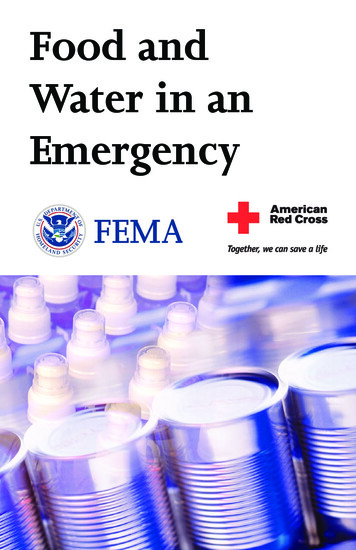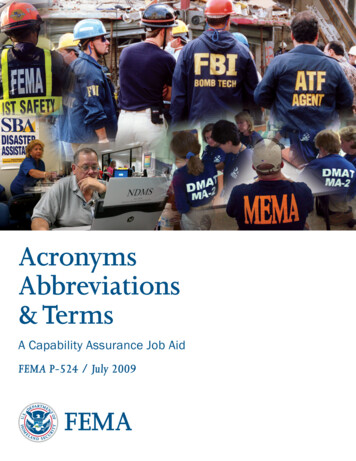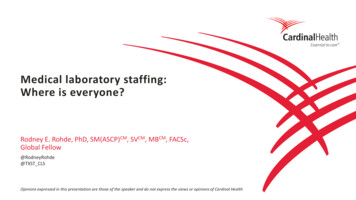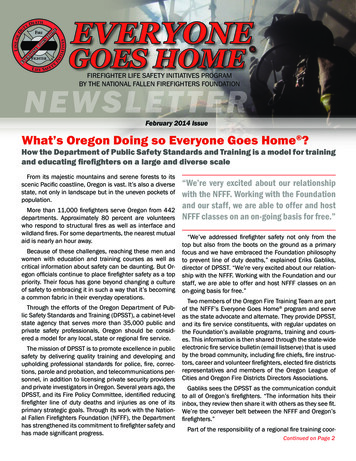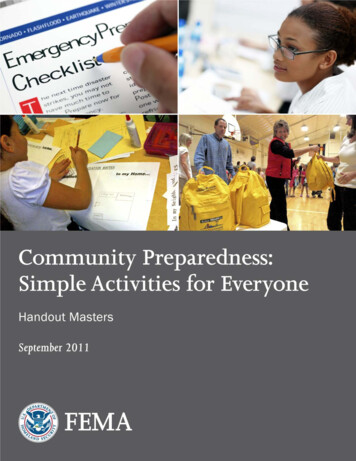
Transcription
Community Preparedness: Simple Activitiesfor Everyone
Community Preparedness: Simple Activitiesfor EveryoneHANDOUT MASTERSPREPAREDNESS ACTIVITIES: HANDOUTSPreparedness on a Shoestring Family Disaster Kit: HandoutWhere Is Everybody? Plan to Stay in Touch: HandoutWho Can You Count on? Who Counts on You? Establishing a Support Network: HandoutEasy Out: Getting to Safety Evacuation Checklist: HandoutStorm Safe: Sheltering in Place Safe Havens: HandoutMark the Safe Spots: HandoutShelter Together: ActivitiesDisaster Plan Dress Rehearsal Dealing With the Disaster Deck: HandoutHunting Home Hazards Home Hazard Hunt: HandoutChemical Emergencies: HandoutAn Ounce of Fire Prevention Fire Prevention Guidelines: HandoutActivities: Getting Fired Up for PreventionPutting Out Fires Fire Basics: HandoutFire Extinguishers: HandoutFire Safety Rules: HandoutHome Safe Home Simple Safety Measures: HandoutSafeguarding Your Valuables Protecting Valuables: Checklist HandoutProtecting Valuables: Tips HandoutSeptember 2011Page i
Community Preparedness: Simple Activitiesfor EveryoneHANDOUT MASTERSPREPAREDNESS ACTIVITIES: HANDOUTS (CONTINUED)Pet/Service Animal Preparedness Protecting Pets and Service Animals: HandoutRx for Readiness “Stay Health” Kit: HandoutGerm Busters ActivitiesGoing Off Grid: Utility Outages Outage Checklist: HandoutComing Home After a Disaster Who Does What? HandoutRecovery Action Plan: HandoutPreparedness: The Whole Community The Whole Community: HandoutNote: The Facilitator Guide has information on how to prepare for and conduct theactivities.September 2011Page ii
Activity Title: Preparedness on a Shoestring
PREPAREDNESS ON A SHOESTRINGFAMILY DISASTER KIT:HANDOUTACTIVITY: DISASTER KIT SCAVENGER HUNTYou may need to survive on your own after an emergency for at least 3 days. Localofficials and responders will be on the scene after a disaster, but they cannot reach everyoneimmediately. Creating a family disaster preparedness kit does not have to be costly—many ofthe items for your family’s kit may be found around your home.You can make a game of getting prepared by organizing a family scavenger hunt. Begin byfinding a container to store the items (e.g., large bucket, pillowcase, backpack, plastic container,etc.). Water—at least 1 gallon per person per day for at least 3 days, for drinking andsanitationCautions: Unopened (sealed) water bottles should be good for at least 1 year. After abottle is opened, the water will begin to grow bacteria in less than a month.Alternative Water Source: If you are unable to purchase water, a typical home waterheater can provide 30 or more gallons of clean drinking water. To use the water in yourtank, first turn off the electricity or gas to the water heater. Then, close the supply valve topreserve the cleanliness of the water in the tank. Next, get the air out of the tank by openingany hot water tap such as the kitchen sink. (Caution: The water coming out of the tank maybe very hot.) You can use a short water hose (e.g., the supply hose to a washing machine)to drain the water from the tank. Use a screwdriver or coin to operate the drainage valve. Ifyou do not have a hose to transfer the water to jugs or pots, use a shallow pan to collect thewater. Allow the tank to fill before restoring power to the water heater. Food—at least a 3-day supply of nonperishable foodWhat To Include: Include ready-to-eat canned or dried meats/tuna, fruits, juices, andvegetables. High-energy foods such as peanut butter, cereals, breakfast bars, etc., are thebest. Add a can opener, scissors, or knife for cutting open foil and plastic pouches, anddisposable plates, cups, and utensils.Tips: Make sure to include food for infants or those on special diets (e.g., medicalrestrictions, food allergies). Pack all these items in plastic bags to keep them dry and asairtight as possible. Keep a list of dates when food items need to be inspected and possiblyreplaced. Remember to include food for pets and service animals.September 2011Page 1
PREPAREDNESS ON A SHOESTRINGFAMILY DISASTER KIT:HANDOUT First aid suppliesWhat To Include: Look for items such as bandages, cotton washcloths, cleaningagent/soap, hydrogen peroxide/isopropyl alcohol, antiseptic cream, and aspirin or an aspirinsubstitute. Include a list of medical conditions and prescription medicines.Tip: Keep your prescriptions in a plastic bag or travel kit in an easy-to-find location. Copies of important informationWhat To Include: Include important information such as phone numbers, family records,insurance and financial documents, and copies of passports, identification documents,Social Security cards, immunization records for people and pets, etc. Radio, flashlight, and batteriesWhat To Include: Include a battery-powered or hand-crank flashlight and radio and extrabatteries.Tips: Avoid using candles, which can easily cause fires. It is advisable to have a WeatherRadio with tone alert. If you are unable to get a Weather Radio, you may be able to listen toalerts on local radio or access them on the Internet at:http://www.nws.noaa.gov/nwr/streamaudio.htm Other supplies and items: You may want to include things such as a whistle to signal forhelp, wrench or pliers to turn off utilities, sanitary products, diapers, and any other itemsyou’ll need during an emergency.Check the expiration dates of items in your kit at least every 6 months.September 2011Page 2
PREPAREDNESS ON A SHOESTRINGFAMILY DISASTER KIT:HANDOUTREMINDERS: WHEN DISASTER STRIKESDisaster can strike quickly and without warning. It canforce you to evacuate your neighborhood or confine you toyour home. Below are some steps you should take if adisaster strikes.PLACE THIS LIST INYOUR DISASTER KIT!Keep InformedListen to local radio or television for news and instructions. WATCH means it is possible that severe weather conditions will develop. WARNING means the weather is already occurring or is likely to occur and that peopleshould take proper protective measures.Bring things indoors such as lawn furniture, trash cans, children’s toys, garden equipment,clotheslines, hanging plants, and any other objects that may be blown around. Confine orsecure your pets in a location in your home or in a carrier for evacuation. Move to a safe areaof your home unless you are instructed to evacuate.Follow Evacuation Orders Evacuate immediately if told to do so. Ignoring an evacuation order puts you and yourfamily in danger. Wear protective clothing and sturdy shoes. Lock your home. Use thetravel routes specified by local authorities; other routes may be impassable or dangerous. Ifyou have only moments before leaving, grab the following items and go: Prescription medications and other essentials Driver’s license, personal identification, insurance information, and other criticaldocuments Disaster kit Notify your family contact. Relatives and friends will be concerned about your safety.Letting someone know your travel plans will help relieve the fear and anxiety of those whocare.September 2011Page 3
PREPAREDNESS ON A SHOESTRINGFAMILY DISASTER KIT:HANDOUTWhen It Is Safe—Assess the Damage Check for injuries. Determine if anyone is injured. If so, call for help and provide simplefirst aid measures. Wear protective clothing and sturdy shoes. Disaster areas and debris contain manyhazards. The most common injury following a disaster is cut feet. Help your neighbors who may require assistance in an emergency situation—infants,elderly people, and people with disabilities—and the people who care for them. Look for hazards. Gas: If you smell gas or suspect a leak, open a window and get everyone outsidequickly. Turn off the gas at the outside main valve. Electrical system: If you see sparks or broken or frayed wires, or if you smell burninginsulation, turn off the electricity at the main fuse box or circuit breaker. Gettingdamaged utilities turned off will prevent further injury or damage. Stay away fromdowned power lines. Water: If the water pipes are broken, turn the water off at the main valve. Tip: For allthe utilities―gas, electric, and water―find out where shutoff valves/switches are beforea disaster strikes. Structural problems: Watch for objects that could fall. Evacuate structures that arenot stable. Spills: Stay away from areas that contain spilled chemicals or other hazardousmaterials.September 2011Page 4
Activity Title: Where Is Everybody?
WHERE IS EVERYBODY?PLAN TO STAY INTOUCH: HANDOUTACTIVITY: DEVELOPING A COMMUNICATIONS PLANIn emergency situations you may need to contact familymembers, friends, or caregivers to check on their safety oradvise them of your status. Follow the steps below todevelop a communications plan. Identify contacts.PUT YOURCOMMUNICATIONSPLAN IN YOURDISASTER KIT!List the names, addresses, phone numbers, and other essential information for familymembers, friends, caregivers, and other frequently used contacts. Here are some tips: Immediate family members include those still living in your home, those who are awaytemporarily (at college, deployed, etc.), and those living elsewhere in your community orin other places. Extended family members, such as parents and other relatives, may live close by or inother places. They, too, may need to be contacted if they are affected by an emergency,or they may need to know your status if the emergency occurred in your area. Some family members may be entrusted to caregivers in group homes, nursing homes,or other facilities or programs. Some may live alone but depend on health care orpersonal care providers for support. Again, you or they may be affected by anemergency and need to be contacted. Don’t forget your pets. They may be left at home or in kennels while you are awayduring the day or on extended periods of travel. In emergencies, you may need to knowif they are safe or if someone can check on them.Be sure to include an out-of town contact. It may be easier to make a long-distance phonecall than to call across town, so an out-of-town contact may be in a better position tocommunicate among separated family members. Organize your contact information into a communications plan.You may also want to prepare wallet cards with contact information, to laminate and store inyour wallet for ready access. (See the next page.) Review your communications plan.After you have assembled your plan and cards, review them with family members and othercontacts to ensure the information is complete and accurate. Add alternate phone numbersor contacts as needed.September 2011Page 1
WHERE IS EVERYBODY?PLAN TO STAY INTOUCH: HANDOUT Share your plan. Be sure every family member knows the phone number of the emergency contact andhas a cell phone, coins to use a pay phone, or a prepaid phone card. Teach family members or friends to use text messaging. Text messages can often getthrough network disruptions when phone calls can’t. If you have a cell phone, program your primary contact as “ICE” (In Case of Emergency).In an accident, emergency personnel will often check ICE listings. Tell your contact thatyou’ve listed him or her as your emergency contact person. Include your communications plan in your family disaster kit. Post a copy on therefrigerator or near a telephone. Distribute copies of your plan to everyone who needsto have one. Update your plan and wallet card as needed. Stay informed.Subscribe to alert services. Many communities now have systems that will send instant textalerts or emails about bad weather, road closings, or local emergencies. Sign up by visitingyour local office of emergency management Web site.September 2011Page 2
WHERE IS EVERYBODY?PLAN TO STAY INTOUCH: HANDOUTAdditional copies of this sheet can be found at http://www.ready.gov.September 2011Page 3
ON YOU?Activity Title: Who Can You Count on? Who Countson You?
WHO CAN YOU COUNT ON? WHO COUNTSON YOU?ESTABLISHING A SUPPORTNETWORK: HANDOUTACTIVITY: WHO CAN YOU COUNT ON? WHO COUNTS ON YOU?Often, during the initial period of a crisis our safety depends on helping each other. Most of usare very willing to help those who may need assistance. Our actions may be limited by notunderstanding how best to offer help. Building a personal support network is an old-fashionedconcept of neighbors helping neighbors. By establishing a personal support network, we knowwho we can count on and who counts on us. And we will be ready to help. Assess Your Capabilities: It is important to evaluate your capabilities, limitations andneeds, and surroundings to determine what type of help you will need in an emergency.QuestionYesNoWill you be able to shut off the necessary utilities (gas, water,electricity)? Can you operate a fire extinguisher? Will you be able to carry your emergency supply kit or criticalassistive/medical devices? Will you be able to move or objects that might block yourevacuation path? Note: You should move or secure objectsthat could block an evacuation route. Are there potential barriers to being able to evacuate? Do youhave an alternate exit path? Are you able to hear or see warnings or announcements? Identify Members of Your Support Network: A personal support network can consist offriends, roommates, family members, relatives, personal attendants, coworkers, andneighbors who will check in with you in an emergency to ensure you are OK and provideassistance if needed. Do not depend on any one person. Identify a minimum of threepeople at each location where you regularly spend your time: job, home, school, volunteersite, etc. Meet With Your Network Members: Invite members of your network to a planning gettogether (making it a social event by adding coffee, tea, and cookies works well). Duringthis session: Discuss each other’s needs and how you can help one another. Explain how you mayneed different help in the event of an evacuation, power outage, darkness, or otherconditions. Provide written emergency contact information with key phone numbers of relatives andmedical professionals. Include relevant medical information, such as the types ofmedications, doses, and locations where items can be found. Also, note any vital thingsto check in the event of a fall or other injury.September 2011Page 1
WHO CAN YOU COUNT ON? WHO COUNTSON YOU?ESTABLISHING A SUPPORTNETWORK: HANDOUT Show the members how to operate and move any assistive devices or specializedmedical equipment. Attach laminated labels to equipment with operating instructions. If you have service animals, make sure that they are familiar with members. Give copies of keys to get into your home or office in case of an emergency. Work out a system for contacting one another during a crisis. Signals can be whistles,shouting, knocking, or visual signs. Do not count on telephones as the only means ofcommunication. Develop a system for letting other know when you will be traveling. Select a way to communicate to let the members of the network know that you are safe. Finally, make a commitment to get together periodically to review the plan."Carry-With-You" Supplies to Keep With You at All Times Emergency health information card Instructions on personal assistance needs and how best to provide them Copy of emergency documents Essential medications/copies of prescriptions (at least a week's supply) Flashlight on key ring Signaling device (whistle, beeper, bell) Small battery-operated radio and extra batteries Packing/Container suggestions: a fanny pack, backpack, or drawstring bag that can behung from a wheelchair, scooter, or other assistive deviceSeptember 2011Page 2
WHO CAN YOU COUNT ON? WHO COUNTSON YOU?ESTABLISHING A SUPPORTNETWORK: HANDOUTSpecialized Supplies to Add to Emergency KitsCheck with your medical provider to determine a sufficient quantity of specialized supplies tolast for up to 2 weeks (medication syringes, colostomy supplies, respiratory aids, catheters,padding, distilled water, etc.). If you have chemical sensitivities or a respiratory or cardiaccondition, store towels, masks, industrial respirators, or other supplies you can use to filter yourair supply. Emergency shelters or first aid stations might not be able to meet your supplyneeds. In an emergency, supplies will be limited.Store supplies in areas you anticipate will be easy to reach after a disaster. If you are unable toafford extras, consider contacting disability-specific organizations such as the Multiple SclerosisSociety, Arthritis Foundation, United Cerebral Palsy Association, etc. They may be able toassist you in gathering low-cost or no-cost emergency supplies and medications. Additionalitems to consider: Extra eyeglasses, hearing aids if you have them or have coverage for them Battery chargers and extra batteries for hearing aids, motorized wheelchairs, or otherbattery-operated medical or assistive technology devices Copies of medical prescriptions, doctor’s orders, and the style and serial numbers of thesupport devices you use Medical alert tags or bracelets or written descriptions of your disability and support needs, incase you are unable to describe the situation in an emergency Supplies for your service animal Medical insurance cards, Medicare/Medicaid cards, physician contact information, list ofyour allergies and health history A list of the local nonprofit or community-based organizations that know you or assist peoplewith access and functional needs similar to yours A list of personal contacts, family, and friends that you may need to contact in an emergency A laminated personal communication board, if you might need assistance with beingunderstood If possible, extra medicine, oxygen, insulin, catheters, or other medical supplies you useregularly If you use a motorized wheelchair, have a lightweight manual chair available foremergencies. Know the size and weight of your wheelchair, in addition to whether or not itis collapsible, in case it has to be transported. Even if you do not use a computer yourself, consider putting important information onto athumb drive for easy transport in an evacuation.September 2011Page 3
EASY OUT: GETTING TO SAFETYActivity Title: Easy Out: Getting to Safety
EASY OUT: GETTING TO SAFETYEVACUATION CHECKLIST:HANDOUTPlan Where will you go? (Choose both a closer location (within the county), and one outside thecounty, in case the type of emergency demands that you go farther away.)Within the county/areaOutside the county/areaHow will you get there? Car Bus Boat Subway Train What route will you take? (Attach road map with evacuation route highlighted or transitmaps.) Will your transportation mode change if you have to evacuate from work? How will youmeet your family? (Make any notes below.) Will you or a household member need assistance to evacuate safely? If so, what kind ofassistance? From whom? Have you talked with them about helping?If so, register with the local emergency management office. Phone number:If you live in a building, make sure your name is on a current log of those needingassistance to exit the building. What will you do with pets or livestock? (Contact your veterinarian or the local humanesociety to find out how to prepare pets/livestock for an emergency.) Note your plans below. What friends or family members should be notified about your evacuation plans?NameNumberNameNumberNameNumberSeptember 2011Page 1
EASY OUT: GETTING TO SAFETYEVACUATION CHECKLIST:HANDOUTPrepare Have extra sets of car keys and house keys made. Make sure maps or transit routes are attached. Make sure the car is running well or that you know how to get to the transit station. Fill the car up with gas or ensure that you have transit fare in advance. Have cash on hand for expenses. If you need assistance to evacuate, make sure you have any needed equipment on hand(example: evacuation chair). Practice telling people quickly and concisely how to assist you if you need help. If you like,write it down here.Go Give yourself plenty of time to prep
to drain the water from the tank. Use a screwdriver or coin to operate the drainage valve. If you do not have a hose to transfer the water to jugs or pots, use a shallow pan to collect the water. Allow the tank to fill bef ore restoring power to the water heater.File Size: 1MB
